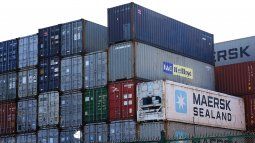Follow the discussion about which negative impact is greater. Rabobank alerts for dairy. Strong rise in transportation. Lack of dollars for inputs. Inflation erodes the price of the farm.
… that the discussion about which negative impact is greater, whether the exchange rate or the withholdings, had two contributions in recent days. In the first case, the elimination of the exchange rate gap in the result of grain production has a greater positive effect than the elimination of withholdings, of between US$30 and US$70 per ton, on corn, wheat and sunflower; while in soybeans the positive impact would be similar for either of the two policies, according to a recent analysis by the Grain Exchange of Buenos Aires, chaired by Jose Martins. According to the entity’s impact study, “the elimination of the exchange gap implies an improvement in the gross margin of US$393/ha for corn (US$60-US$70/t), vs. US$59/ha with the reduction of export duties; for wheat the relationship is US$71/ha (gap) vs. US$21/ha (withholdings) and for sunflower US$84/ha (gap) against US$10/ha (withholdings). At the same time, in soybeans, an elimination of export duties would imply an improvement of 171, a figure comparable to the 148 of the elimination of the gap, “says the Stock Exchange. For its part, with the accompaniment of Barbechado, the FADA Foundation from Cordoba, made a presentation at the Deputies Agriculture Commission, to “eliminate” withholdings, and create 400,000 jobs in 10 years. According to the analysis, the positive impact of the disappearance of the tax would show a growth of almost 60% in grain production (to more than 200 million tons); of 1 million t in bovine meat, and the same in pork; and the possibility of an increase in the cut percentage with biofuels of at least 15%-20%, among others. The growth would take Argentine grain exports to US$85 billion, with an impact of 2.5 points on GDP. As they explained, the proposal is based on the immediate elimination of 12 points for all products, which leaves only soybeans paying 21% tax (instead of the current 33), a percentage that, in turn, would have a gradual reduction, it would be taken to Profit account, transitory, transferable, and would be amortized in installments from the 5th year. The measure, with a strong (positive) impact in the provinces, should be considered prior to the treatment of the Budget bill that should enter Congress in September. The presentation was summarized in “one dollar, zero restriction, zero retention”.
The content you want to access is exclusive to subscribers.
…that, with the exception of the US, “dairy companies in Western Europe, Australia, Brazil, China and other emerging markets are experiencing weaker-than-expected sales in 2023 (mainly in volume terms)”, notes the latest quarterly report from the specialized bank Rabobank which also highlights that “global milk production continues to grow, but is losing momentum”, and puts on warning lights. This despite the fact that “starting in May, the prices of the main input for food, corn, decreased 25% year-on-year in Chicago, and prices would continue to fall (due to the second corn crop in Brazil, added to the large grain exports from Russia, the renewal of the grain corridor agreement between Russia and Ukraine, an upcoming good harvest in the EU, and the accelerated planting of corn in the US)”. In turn, “Chicago soybean prices fell 13% year-on-year.” However, despite this drop in feed, the prices of milk at the farm are decreasing globally”. For South America, Rabobank points out that “South American milk production continues to be under pressure. With lower feed costs, Brazilian milk production should experience year-on-year growth in the second and third quarters, despite a clear trend of lower farm-gate milk prices. However, Argentina would experience a significant contraction in production, given the low availability of forage after the dry season.”


… that, while Angus prepares to finish off tomorrow (in Agroactiva) the players of the Autumn Special, the people from Fearca who unite the aero-applicators alerted about the lack of dollars, for spare parts, repairs and fuel; This issue is also having a strong impact on international freight, and worries production as it deals with strategic inputs and services. In this sense, “the costs to move local merchandise by truck in Argentina increased 11.85% in May. With this result, only so far this year, the increase climbs to 44.6%, according to Fadeeac.
Source: Ambito




